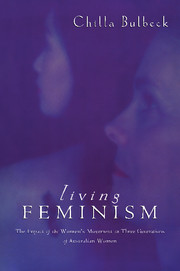Part One - Women's Lives Through A Feminist Lens
Published online by Cambridge University Press: 20 May 2010
Summary
The invisibility of the historical contribution of women weakens the current status of women by diminishing self esteem and the collective sense that women have ‘earned the right’ to choose the lifestyle they want.
(House of Representatives Standing Committee on Legal and Constitutional Affairs 1992:v)A history of women's liberation written from archives and remembrances is now a flourishing sub-industry in academic feminism (Curthoys 1992; Burgmann 1993; Ryan 1992), including the ‘first fulllength book in Australia on this topic’ (Kaplan 1996:xi). The present text focuses on the impact of women's liberation on so-called ordinary women, but a brief history of Australian feminist activism, achievements and defeats will contextualise the discussion of women's experiences of growing up; of giving meaning to their bodies as sexualised; of education, work, motherhood and marriage.
Nineteenth-Century Feminist Struggles
Had one of the earlier generation of feminists – those who were active in the decades around the turn of the century – looked back over the last forty years from the perspective of about 1920, she too might have written a letter both celebratory and anxious to the next generation. She would have noted that forty years ago women did not have the right to vote or stand for parliament, a right still denied many women in other nations.
- Type
- Chapter
- Information
- Living FeminismThe Impact of the Women's Movement on Three Generations of Australian Women, pp. 19 - 25Publisher: Cambridge University PressPrint publication year: 1997



